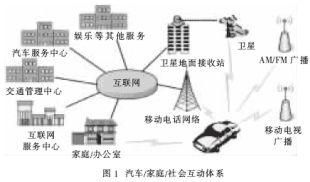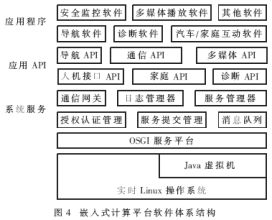The widespread use of electronic devices in automobiles is considered a revolution in the development of automotive technology. With the development of automotive electronic technology and the increase of automotive control units, automotive electronic technology is developing in the direction of centralization, intelligence, networking and modularization. The use of CAN / LIN bus network in the car allows the data of each control unit in the car to be shared, thus making it possible to use multi-variable and multi-objective integrated coordinated control on the embedded computing platform of the car. On the other hand, the network expands the service field of automobiles, provides a technical basis for automobile mobile communications, mobile office, entertainment, navigation and positioning, and remote diagnosis and maintenance, and gradually forms an interactive system of automobile, family, and social integration. Automotive embedded computing platforms play an important role in this integrated system.
This article introduces the in-vehicle embedded computing platform, which provides a good software and hardware platform for completing various functions such as automobile assisted driving and safety monitoring, remote diagnosis and maintenance, online / offline navigation and positioning, entertainment, and interaction with the family. The following will be described from three aspects: car / family / social integration architecture, computing platform hardware system, and software system.
1 Automotive / family / social integration architecture
The automotive embedded computing platform provides a good software and hardware platform for realizing various functional services. The combination of the off-vehicle network and the in-vehicle network constitutes an interactive system structure of car / family / social integration. The schematic diagram of the architecture is shown in Figure 1, and the schematic diagram of the in-vehicle computing network is shown in Figure 2.


In Figure 1, the traffic management center, car service center, Internet service center, and entertainment service center together form a car remote service platform, and the home / office and car form a car / family interactive platform system. It mainly provides three types of services:
(1) Automotive integration services. Mainly refers to the automobile remote diagnosis service and the automobile optimal control plan service. The automotive computing platform reads the fault code generated by the electronic control module (ECM) diagnosis through the CAN / LIN bus, and then sends it to the nearest automotive service center through the automotive gateway using wireless communication technology. The car service center analyzes the fault code to form a diagnostic solution and sends it to the car embedded gateway in the form of service. After protocol analysis, it is sent to the car embedded computing platform, and finally displayed to the driver through the human-machine interface. Car manufacturers also provide services to download the best car control solutions for cars to suit their operation under different driving conditions. These services are mainly provided by car remote service platforms or car manufacturers.
(2) Navigation and location services. The application layer software running on the vehicle-mounted embedded platform receives the data sent by the GPS receiver, and realizes the navigation by means of the vehicle-mounted geographic information system (electronic map). In addition, the application layer software can also send the data received by GPS to a remote car service platform or a third-party service provider, who then sends the navigation information to the car embedded platform as a service. These services require high accuracy and timeliness. How to accurately and efficiently transfer this information becomes the key to determine the quality of such services.
(3) Personal / entertainment information service. The car / family interactive platform system allows people to understand the situation in the home while driving the car, and connect the car-family as one. Telematics (TelemaTIcs) systems are becoming increasingly prominent. It transmits safe and confidential information or entertainment information to the car in a service (Service) manner through wireless communication technology.
2 Hardware architecture of automotive embedded computing platform
The design of the hardware platform must be determined according to the function to be completed. This project is to integrate the automotive embedded gateway into the computing platform. Therefore, the functions to be completed by the computing platform are: wireless communication function with the remote service center; navigation function; audio and video playback function; access to the vehicle through the CAN / LIN bus Functions of internal electronic control module, etc. The EP9315 processor based on the 32-bit ARM core has good computing power and rich peripheral interfaces. After appropriate peripheral expansion, the automotive embedded computing platform shown in Figure 3 is designed.

EP9315 is a highly integrated system-on-chip processor. It has a 200MHz ARM920T processor and a memory management unit (MMU) supporting Linux, Windows CE and many other embedded operating systems. EP9315 has a high-performance 1/10/100 Mbps Ethernet media access controller (MAC) and external interface, which can connect SPI, I2S audio, Raster / LCD, IDE storage peripherals, keypad and touch screen. The device also integrates a three-port USB 2.0 full-speed host running at 12Mbps and three UARTs. The wireless network card with PCMCIA interface provides the remote network access function, which can realize the access to the network server of the remote service center. The electronic hard disk with IDE interface is used to store geographic information system and provide electronic map for navigation software. The GPS receiver is connected to the EP9315 processor through a serial port to provide real-time vehicle geographic location information. The touch screen is a man-machine input interface, used to complete various user information settings. The LCD display and the speaker are man-machine output interfaces, which can play MPEG4 video or prompt voice alarm information. The CAN / LIN bus interface can be connected to the CAN / LIN bus in the car to provide access to the CAN / LIN bus in the car. The software designed based on the above hardware platform can well complete the various functions to be completed by the computing platform.
3 Software architecture of automotive embedded computing platform
The software platform is designed with embedded Linux. The functions of the software part have been described above. The navigation task is a real-time task, and Linux does not have real-time functions, so Linux needs to be improved to support real-time tasks. The software architecture based on real-time Linux is shown in Figure 4. 
After the system is powered on, first start the LINux operating system, then start the QT engine, and then start the QT main program. The selection buttons of each application are displayed on the LCD display, and the corresponding application is started by pressing the corresponding button through the touch screen. The following describes the execution flow of the main application.
(1) Navigation application. After the navigation program starts, the user inputs the starting point and destination point of the journey through the touch screen. The navigation software sends the starting point and destination point to the navigation service center (in this project is a computer in the wireless local area network), and calls the navigation API every certain time to receive the real-time geography of the current vehicle sent by the GPS receiver from serial port 1 The location data, and then call the communication API, send the geographic location data to the navigation service center through the wireless network card. The navigation service center calculates the optimal travel path based on the received starting point and destination point of the journey, and each time the vehicle location information is received, it calculates the location of the current vehicle, including the current vehicle position and the path that should be used. The location image of the range is sent to the vehicle. The navigation software on the car displays the received image on the LCD, through which the driver can understand the current position of the vehicle and the route to be taken next.
(2) Diagnostic application software. After the diagnostic service software is started, the software calls the diagnostic API to read the fault codes of each ECU connected to the CAN / LIN bus, and then calls the communication API to send these codes to the car service center (this project is the same as the navigation service center Computer). The car service center analyzes the fault code, determines the specific fault condition of the car, and sends the final result to the car embedded platform through the wireless network. The car embedded platform receives these data through the wireless network card, and the diagnostic service software reads the data and displays it on the LCD.
(3) Car / family interactive application software. When running the home / car interactive system software on the car embedded platform, the software displays the various appliances in the home and their status on the LCD. When the user issues a command to change the status of an appliance through the touch screen, the car / home interactive software calls the home API function to send the command to the home gateway (provided by a social third-party service company). The software that implements the OSGI protocol is running on the home gateway. The software can complete the received commands and send the execution results to the automotive embedded platform.
(4) Security monitoring software. The CCD camera inputs the image of the car's driving lane to the DSP processing system. The DSP processing system analyzes the image data and sends the analysis results to the security monitoring software running on the car's embedded platform. The monitoring software analyzes the data. If the car deviates from the driving lane, the monitoring software calls the multimedia API to remind the driver through the speaker or display information on the LCD, so as to achieve safety monitoring and alarm functions.
Kitchen Hot Plate,Electric Solid Hotplate,High Powered Hotplate,Cooking Plate
Shaoxing Haoda Electrical Appliance Co.,Ltd , https://www.hotplates.nl